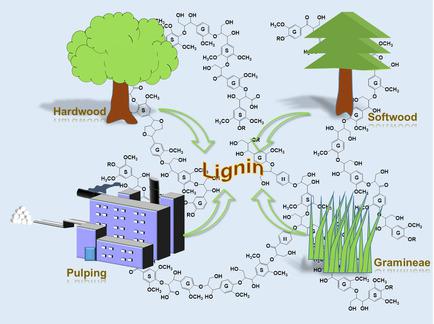当前位置:
X-MOL 学术
›
ChemSusChem
›
论文详情
Our official English website, www.x-mol.net, welcomes your feedback! (Note: you will need to create a separate account there.)
Lignin Source and Structural Characterization.
ChemSusChem ( IF 8.4 ) Pub Date : 2020-07-08 , DOI: 10.1002/cssc.202001324 Run-Cang Sun 1
ChemSusChem ( IF 8.4 ) Pub Date : 2020-07-08 , DOI: 10.1002/cssc.202001324 Run-Cang Sun 1
Affiliation

|
Lignin is a primary component of lignocellulosic biomass and an underutilized feedstock in the growing pulping and biofuel industries. Currently, over 50 million tons of industrial lignin are produced annually from pulping and bioethanol processes in the world. Around 95 % of industrial lignin is burned as fuel in heat and power plants due to its complicated, destructive, and condensed structures hindering direct industrial utilization, while the remaining 5 % of lignin is used for potential applications, such as additives, binders, dispersants, and surfactants, through modification. Meanwhile, different biorefinery processes also produce a considerable amount of lignin with various structural features and properties. The development of technologies for its structural characterization is currently desirable for lignin valorization, which will improve the techno‐economics of applications of lignins in industries.
中文翻译:

木质素来源和结构表征。
木质素是木质纤维素生物质的主要成分,并且在不断增长的制浆和生物燃料行业中未被充分利用。目前,全球每年通过制浆和生物乙醇工艺生产超过5000万吨的工业木质素。由于木质素的复杂,破坏性和冷凝结构阻碍直接工业利用,约有95%的木质素在火力发电厂中作为燃料燃烧,而其余5%的木质素则用于潜在的应用,例如添加剂,粘合剂,分散剂和表面活性剂,通过改性。同时,不同的生物精炼工艺还会产生大量具有各种结构特征和特性的木质素。目前需要开发用于结构表征的技术,以进行木质素增价,
更新日期:2020-09-10
中文翻译:

木质素来源和结构表征。
木质素是木质纤维素生物质的主要成分,并且在不断增长的制浆和生物燃料行业中未被充分利用。目前,全球每年通过制浆和生物乙醇工艺生产超过5000万吨的工业木质素。由于木质素的复杂,破坏性和冷凝结构阻碍直接工业利用,约有95%的木质素在火力发电厂中作为燃料燃烧,而其余5%的木质素则用于潜在的应用,例如添加剂,粘合剂,分散剂和表面活性剂,通过改性。同时,不同的生物精炼工艺还会产生大量具有各种结构特征和特性的木质素。目前需要开发用于结构表征的技术,以进行木质素增价,


























 京公网安备 11010802027423号
京公网安备 11010802027423号